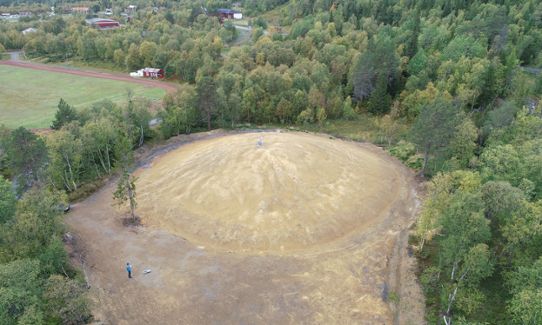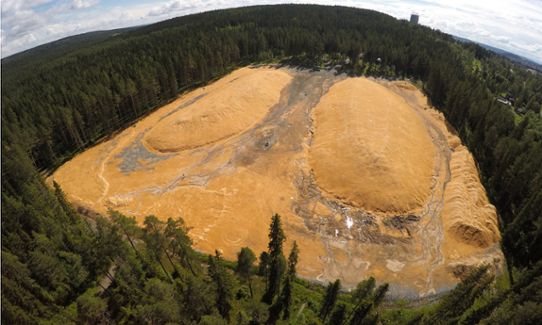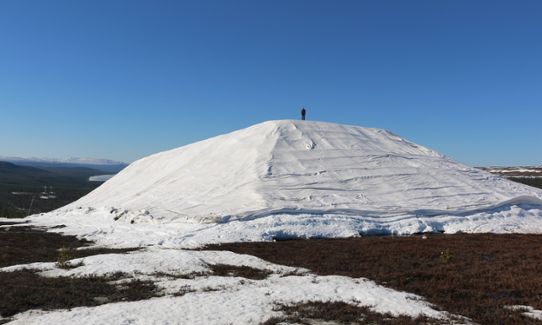Average temperatures in Sweden are increasing, and one of the consequences of this is milder winters with more places experiencing less snow. In the future, it is expected that there will be a significant decline in the numbers of days with snow cover with a water content of at least 5 or 20 millimetres respectively outside the fell mountain regions.
Snow storage creates a sense of security for ski resorts
Snow reserve in Vålådalen. Photo Peak Innovation
A large majority of Sweden’s ski resorts manufacture artificial snow in order to be able to offer their visitors a more stable cover of snow. Artificial snow has a lower air content than natural snow, which makes it more able to withstand the wear caused by skiers on slopes or on cross-country trails. In order to manage their supply of snow, several ski resorts have begun to store this durable snow over the summer. This provides a greater assurance of snow ready for the next skiing season, making them less vulnerable to mild temperatures in early winter. Snow storage provides snow security, which is reassuring for ski resorts and skiers alike.
Certain resorts for cross-country skiing, such as those in Östersund and Ulricehamn, store snow in order to be able to arrange their World Cup cross-country skiing competitions, whilst Idre Fjäll, for example, stores snow in order to offer an early opening date for both downhill and cross-country skiing. Outside of Sweden, snow is being stored too. Lillehammer in Norway and Ruka and Kontiolahti in Finland store snow, and in the Alps, even glaciers are being preserved using similar methods, in addition to regular snow storage. Even small ski resorts are now storing snow in order to be less vulnerable during mild winters.
Certain downhill skiing resorts re-use snow from one season to the next, which enables them to avoid producing new snow, devoting their resources instead to collecting the snow at the end of the season. However, it is most common that resorts produce new artificial snow for storage, as the costs and energy consumption of collecting snow often exceed those of new production.
Snow storage in practice
The snow that is to be stored can either be collected using excavators and snow groomers or produced directly for storage. A smaller surface area for the snow pile results in less snow loss during the storage period. A tall but slim, steep-sided pile of snow is therefore often preferred to a low, wide pile. At the same time, the critical angle of repose of a 10-metre high snow pile could make the base up to 30 metres in breadth, so this will affect the choice of where the pile can be placed. Another important consideration is that there must not be any waterway in the vicinity of the snow pile. It has happened before that tiny streams and meltwater from remaining snow have carved a passage beneath the snow piles to such an extent that, by the end of the summer, there has been enough room for an adult person to pass through. The presence of water at the base also creates ice at the bottom of the snow pile, which makes that part of the pile unusable.
If the snow that is to be stored is artificial snow that needs to be produced using a snow cannon or similar, the temperatures must be below freezing. If large quantities of snow need to be produced, this could require one or more intensive periods of snow production at times of prolonged sub-zero temperatures.
The covering material used is either cloth or some kind of wood derivative, such as bark, woodchips or sawdust. When using sawdust, it is recommended that the coverage has a thickness of at least 30-50 cm. The natural wooden material absorbs moisture from rain and dew, which then evaporates during warmer days. Similarly, the covering layer also provides protection against incoming heat radiation during the daytime, while also emitting stored heat during the night, functioning as a kind of heat buffer. One disadvantage of using sawdust is that the top layer of snow will be lost when the sawdust is separated from the snow pile.
The objective of snow storage is to keep costs at a minimum while also storing the right amount of snow to meet the resort’s demands. The present potential for snow storage using sawdust in southern Sweden involves a volume reduction of around 20 per cent. In Östersund, situated in the middle of Sweden, a level of around 10 per cent has been achieved, while in other resorts it is not uncommon for 30 per cent to be lost.
Östersund's 60 000 cubic meters of snow snow under a duvet of saw dust. Photo Peak Innovation
Snow storage with canvas, Idre Fjäll. Photo Peak Innovation
In the Scandinavian climate, more than one layer is recommended when using cloth to protect snow piles. Resorts and researchers have also tested insulation using various materials between two cloths. With the use of a single layer of cloth, the snow volume reduces by 50-60 per cent. With two layers of cloth, 40-50 per cent is lost. The potential for two cloths separated by a layer of insulating material is even greater. The advantages of using cloth is that the snow is kept clean by not becoming mixed with sawdust, the cloth weighs less so is easier to transport up ski slopes, and the cloth requires less storage space during the winter when not in use.
Beginning to store snow
If a resort is considering beginning to store snow, it is important to have a clear goal for the storage – to know what it will be used for. The goal of being able to organise a World Cup cross-country competition in the middle of Sweden in December would require a particular approach. If the goal is to be able to open two slopes for downhill skiing in southern Sweden for the school holiday at the end of February, the demands and approach will be different. It involves planning, expense and extra work, but it could also provide the ski resort with snow security for their planned event or opening date even in the absence of low temperatures or sufficient snowfall.
Once the resort’s goals have been defined, it must then be determined how much snow will be needed. This will be followed by the planning of how the snow storage can be optimised. It is easy to waste a lot of money, energy and snow by beginning to store snow without the requisite knowledge.
More examples of climate adaptation
This is one of many examples of climate adaptation. There are more in the collection of ideas being built up by the Swedish National Knowledge Centre for Climate Change Adaptation at the Swedish Meteorological and Hydrological Institute (SMHI). The collection of examples has the aim of sharing experiences and providing ideas to everyone who works with climate adaptation. Examples describe concrete measures and challenges in several subject areas. They show how different actors have worked to adapt their activities to the climate changes that are already being noticed today and those that we cannot prevent in the future.


